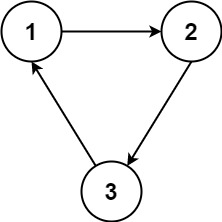C++
Java
Python
Python3
C
C#
JavaScript
TypeScript
PHP
Swift
Kotlin
Dart
Go
Ruby
Scala
Rust
Racket
Erlang
Elixir
monokai
ambiance
chaos
chrome
cloud9_day
cloud9_night
cloud9_night_low_color
clouds
clouds_midnight
cobalt
crimson_editor
dawn
dracula
dreamweaver
eclipse
github
github_dark
gob
gruvbox
gruvbox_dark_hard
gruvbox_light_hard
idle_fingers
iplastic
katzenmilch
kr_theme
kuroir
merbivore
merbivore_soft
mono_industrial
nord_dark
one_dark
pastel_on_dark
solarized_dark
solarized_light
sqlserver
terminal
textmate
tomorrow
tomorrow_night
tomorrow_night_blue
tomorrow_night_bright
tomorrow_night_eighties
twilight
vibrant_ink
xcode
上次编辑到这里,代码来自缓存 点击恢复默认模板
class Solution {
public:
int minimumSemesters(int n, vector<vector<int>>& relations) {
}
};
运行代码
提交
golang 解法, 执行用时: 28 ms, 内存消耗: 6.7 MB, 提交时间: 2023-10-22 10:48:23
func minimumSemesters(n int, relations [][]int) int {
graph := make([][]int, n+1) //邻接表
for i:=0; i<n; i++ {
graph[i] = []int{}
}
indegree := make([]int, n+1) //入度表
for i:=0; i<len(relations); i++ { //构建邻接表和入度表
first, second := relations[i][0], relations[i][1]
graph[first] = append(graph[first], second)
indegree[second]++
}
var queue []int
for i:=1; i<n; i++ { //入度为0的点写入队列
if 0 == indegree[i] {
queue = append(queue, i)
}
}
ans := 0
visit := 0 //课程访问数量
for 0 != len(queue) {
ans++ //入度同时为0的节点在一个学期内一起修
size := len(queue)
for i:=0; i<size; i++ { //将同一批入度为0的节点修完
cur := queue[i]
for _, nxt := range graph[cur] {
indegree[nxt]--
if 0 == indegree[nxt] { //入度为0,写入队列,为下一批修的课程
queue = append(queue, nxt)
}
}
visit++
}
queue = queue[size:]
}
if visit != n { //如果课程访问数量 != 课程数,肯定存在环
return -1
}
return ans
}
python3 解法, 执行用时: 68 ms, 内存消耗: 20.5 MB, 提交时间: 2023-10-22 10:48:02
class Solution:
def minimumSemesters(self, N: int, relations: List[List[int]]) -> int:
graph = {i: [] for i in range(1, N + 1)}
for start_node, end_node in relations:
graph[start_node].append(end_node)
visited = {}
def dfs(node: int) -> int:
# 返回最长路(含)
if node in visited:
return visited[node]
else:
# 标记为正在访问
visited[node] = -1
max_length = 1
for end_node in graph[node]:
length = dfs(end_node)
# 我们遇到了一个环!
if length == -1:
return -1
else:
max_length = max(length+1, max_length)
# 标记为已经访问过
visited[node] = max_length
return max_length
max_length = -1
for node in graph.keys():
length = dfs(node)
# 我们遇到了一个环!
if length == -1:
return -1
else:
max_length = max(length, max_length)
return max_length
python3 解法, 执行用时: 76 ms, 内存消耗: 20.6 MB, 提交时间: 2023-10-22 10:47:45
class Solution:
def minimumSemesters(self, N: int, relations: List[List[int]]) -> int:
graph = {i: [] for i in range(1, N + 1)}
for start_node, end_node in relations:
graph[start_node].append(end_node)
# 检查图中是否有环
visited = {}
def dfs_check_cycle(node: int) -> bool:
# return True if graph has a cycle
if node in visited:
return visited[node]
else:
# 标记为正在访问
visited[node] = -1
for end_node in graph[node]:
if dfs_check_cycle(end_node):
# 我们遇到了一个环!
return True
# 标记为已经访问过
visited[node] = False
return False
# if has cycle, return -1
for node in graph.keys():
if dfs_check_cycle(node):
return -1
# 如果没有环,返回最长路
visited_length = {}
def dfs_max_path(node: int) -> int:
# 返回最长路(含)
if node in visited_length:
return visited_length[node]
max_length = 1
for end_node in graph[node]:
length = dfs_max_path(end_node)
max_length = max(length+1, max_length)
# 储存
visited_length[node] = max_length
return max_length
return max(dfs_max_path(node)for node in graph.keys())
python3 解法, 执行用时: 68 ms, 内存消耗: 18.4 MB, 提交时间: 2023-10-22 10:47:28
class Solution:
def minimumSemesters(self, N: int, relations: List[List[int]]) -> int:
graph = {i: [] for i in range(1, N + 1)}
in_count = {i: 0 for i in range(1, N + 1)} # 或者入度
for start_node, end_node in relations:
graph[start_node].append(end_node)
in_count[end_node] += 1
queue = []
# 我们使用 list 因为我们
# 在这份代码中不会弹出前面的元素
for node in graph:
if in_count[node] == 0:
queue.append(node)
step = 0
studied_count = 0
# 开始使用BFS学习
while queue:
# 开始一个新学期
step += 1
next_queue = []
for node in queue:
studied_count += 1
end_nodes = graph[node]
for end_node in end_nodes:
in_count[end_node] -= 1
# 如果所有先修课程都已经学习
if in_count[end_node] == 0:
next_queue.append(end_node)
queue = next_queue
return step if studied_count == N else -1
cpp 解法, 执行用时: 56 ms, 内存消耗: 26.3 MB, 提交时间: 2023-10-22 10:47:15
class Solution {
public:
int minimumSemesters(int N, vector<vector<int>>& relations) {
vector<int> inCount(N + 1, 0); // 或者入度
vector<vector<int>> graph(N + 1);
for (auto& relation : relations) {
graph[relation[0]].push_back(relation[1]);
inCount[relation[1]]++;
}
int step = 0;
int studiedCount = 0;
vector<int> bfsQueue;
for (int node = 1; node < N + 1; node++) {
if (inCount[node] == 0) {
bfsQueue.push_back(node);
}
}
// 开始使用 BFS 学习
while (!bfsQueue.empty()) {
// 开始一个新学期
step++;
vector<int> nextQueue;
for (auto& node : bfsQueue) {
studiedCount++;
for (auto& endNode : graph[node]) {
inCount[endNode]--;
// 如果所有先修课程都已经学习
if (inCount[endNode] == 0) {
nextQueue.push_back(endNode);
}
}
}
bfsQueue = nextQueue;
}
// 检查是否学习所有课程
return studiedCount == N ? step : -1;
}
};
java 解法, 执行用时: 6 ms, 内存消耗: 43.8 MB, 提交时间: 2023-10-22 10:47:02
class Solution {
public int minimumSemesters(int N, int[][] relations) {
int[] inCount = new int[N + 1]; // 或者入度
List<List<Integer>> graph = new ArrayList<>(N + 1);
for (int i = 0; i < N + 1; ++i) {
graph.add(new ArrayList<Integer>());
}
for (int[] relation : relations) {
graph.get(relation[0]).add(relation[1]);
inCount[relation[1]]++;
}
int step = 0;
int studiedCount = 0;
List<Integer> bfsQueue = new ArrayList<>();
for (int node = 1; node < N + 1; node++) {
if (inCount[node] == 0) {
bfsQueue.add(node);
}
}
// 开始使用 BFS 学习
while (!bfsQueue.isEmpty()) {
// 开始一个新学期
step++;
List<Integer> nextQueue = new ArrayList<>();
for (int node : bfsQueue) {
studiedCount++;
for (int endNode : graph.get(node)) {
inCount[endNode]--;
// 如果所有先修课程都已经学习
if (inCount[endNode] == 0) {
nextQueue.add(endNode);
}
}
}
bfsQueue = nextQueue;
}
// 检查是否学习所有课程
return studiedCount == N ? step : -1;
}
}

